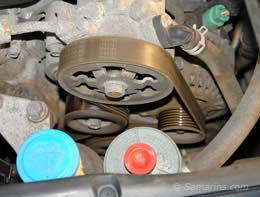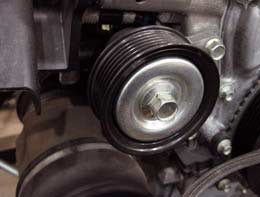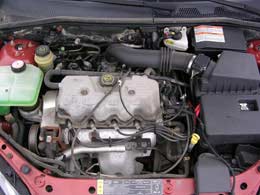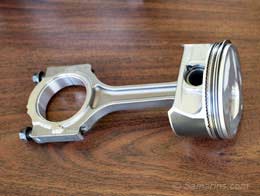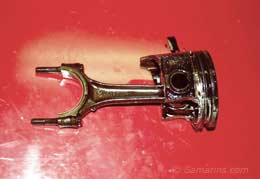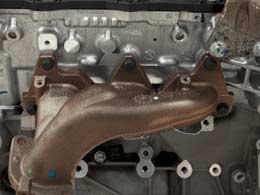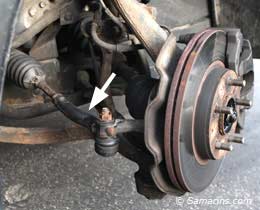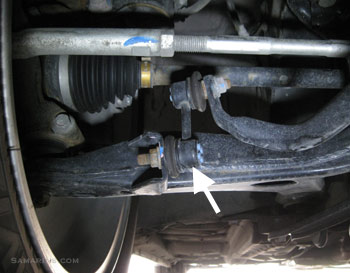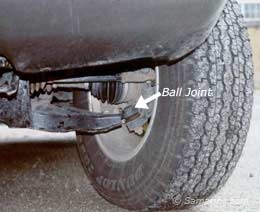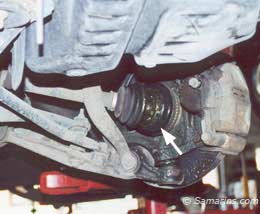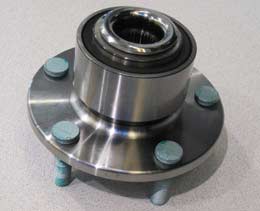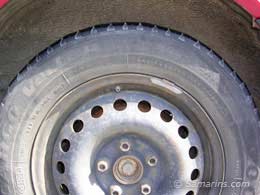 Check Engine or Malfunction indicator light (MIL) |
The Check Engine or Service Engine Soon light or an icon resembling the engine is called, in technical terms, the Malfunction Indicator Light or MIL. The MIL light comes on when your vehicle's computer detects a fault that can affect your vehicle's fuel economy and the exhaust emissions. There is no button to reset the Check Engine light, but if the fault that caused it doesn't happen again, the light will turn off by itself. If the MIL light stays on, have the problem checked out, because in some cases, the problem could get worse if not repaired in time. Think of the Check Engine light as an early warning sign.
How the OBDII system works
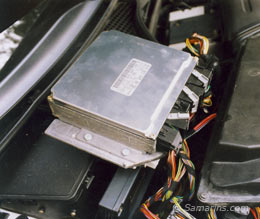 The Engine Computer or ECM |
All modern cars and trucks have a computer (in the photo) that controls the operation of the engine, automatic transmission and emission control systems. This computer is usually called the Electronic Control Module or ECM (SAE term: Powertrain Control Module or PCM). The main purpose is to keep the engine performing at the most efficient level while keeping the exhaust emissions low. To achieve this, the ECM constantly adjusts the engine and transmission parameters according to the speed, load, engine temperature, gasoline quality, ambient air temperature and other conditions. We usually don't notice how it works, but from the moment you turn the ignition on, everything is controlled by the computer. On some cars, even after the car is shut off, the ECM runs some tests to check some of the components.
All passenger cars and trucks sold in North America since 1996 are OBD-II compliant. The OBD-II or On-Board Diagnostics version II standard among other things requires the vehicle computer system to have a self-testing capability. The ECM constantly monitors all the sensors and periodically tests electronic components and emission control systems. If the ECM detects a problem with some of the electronic components or the signal from one of the sensors is out of normal range, it turns the Malfunction Indicator Light or MIL on. At the same time, it stores the correspondent diagnostic trouble code (DTC) in its memory. For some problems, the ECM also stores the freeze frame of the engine parameters at the moment the fault was detected. Read more about the freeze frame below.
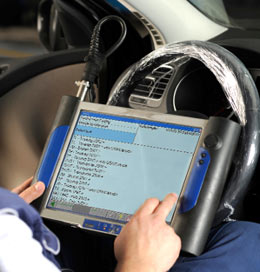 A technician scanning the car computer with a scan tool |
Once you take your car to a dealer or repair shop, a technician will hook up the scanner to the car's OBDII diagnostic connector and retrieve the stored diagnostic trouble code or codes, as well as the freeze frame. Then, he (she) will look up the code in the service manual provided by a car manufacturer. The service manual contains the list of diagnostic trouble codes (around a few hundreds) and describes what each code means, how to troubleshoot it and what parts need to be tested. The diagnostic trouble code itself doesn't tell exactly what component is defective; it only indicates where to look, what engine parameter was out of normal range. The technician will have to perform further testing to pinpoint a defective part. Once the repair is completed, a technician will reset the "Check Engine" light. If you have necessary skills, a good scan tool and the repair manual, you can diagnose the problem yourself. Read more about this below.
Q: What to do if my "Check Engine" light comes on?
A: If the "Check Engine" light came on soon after a fill-up at a gas station, check if your gas cap is closed properly. Secure the gas cap if it wasn't tight, and if there are no other problems, the "Check Engine" light should reset by itself after a few trips. If the gas cap was tight, there is some other problem with the engine, transmission or emission control system components in your vehicle. You should have your car computer scanned to see what is wrong. It could be some minor or intermittent issue; but it also could be something that can cause more damage to your vehicle if not repaired in time. Typically dealers and auto repair shops charge a diagnostic fee for scanning the car computer. Some auto parts stores and auto repair shops, however, advertise that they will scan you car for free, in hopes that you will buy parts or do the repairs at their shop. Try googling 'free check engine light scan' + ' your town' to find a shop that will scan your car for free. Once you know the code, you can google it again along with your car make and model, e.g., P0171 Ford Explorer. Do a little research and you will have an idea what is the problem and what to do, because somebody probably had the same problem before and posted the information. We also have common check engine codes listed along with examples of possible problems along with common repairs; check here: OBDII trouble codes.
If your car is not too old, have it scanned at your dealer, because it's possible that the problem is still covered by the emission warranty and can be repaired for free or a minimum charge. The US Federal Emission Warranty covers major emission control components for the first 8 years or 80,000 miles. Check your warranty booklet for details, or call your dealer. Again, doing some research ahead of time can help in case the dealer refuses to warranty your problem.
Q: Is it safe to drive with the "Check Engine" light on?
A: It really depends what the problem is, what caused the "Check Engine" to come on. It could be something really minor, but it also could be something more serious that needs to be taken care of as soon as possible. In worst cases driving with the "Check engine" light may cause more damage to the vehicle. Here is a very common example:
Often, due to a bad mass air flow sensor, vacuum leak or some other reason, the air-fuel mixture entering the engine becomes lean or there is too much air and too little fuel. The engine computer tries to compensate by adding more fuel, but it only can compensate within a certain limit. If the engine computer can no longer compensate the lean condition, it turns on the check engine light and store the corresponding code in its memory, typically P0171 - System Too Lean (Bank 1) or P0174 - System Too Lean (Bank 2). If caught in time, this problem may require a simple repair and more troubles could be avoided as the lean air-fuel mixture causes pre-ignition or detonation, and this could lead to serious engine problems. If your check engine light came on, I certainly recommend to have your car checked out as soon as possible to be on a safe side. If the Check Engine light is flashing, it means that the engine computer (ECM) has detected that your engine is misfiring. Driving with a misfiring engine could damage your catalytic converter, which is a very expensive part. Often the misfiring could be caused by bad spark plugs and wires; if you haven't done a tune-up in a while, it might be a good idea to do it now for a start.
Q: Will disconnecting the battery reset the "Check Engine" light?
A: Disconnecting the battery may reset the Check Engine light in some cars, but it will come back anyway if the problem is still there. Besides, the problem may still be covered by the emission warranty (typically 8 years or 80,000 miles) and repaired free of charge by your dealer. Also, the readiness code will be erased, which may prevent your car from completing an emissions test (I/M). The readiness code is an indication that certain emission control components of your car have been self-tested. In addition, the radio, if code-protected, may be locked after disconnecting the battery.
Q: How long does it take for check engine light to reset?
A: If the problem that caused the check engine light to come on is fixed or no longer exists, the check engine light will turn off. For some faults, it may take just a few minutes of driving; for other problems, it may take a few trips. This is because it takes time for a car computer to re-test all the components. If the Check Engine light doesn't clear itself after a couple days of driving, the problem is most likely still there.
Q: Can overfilling the gas tank cause Check Engine light to come on?
A: Yes, overfilling the gas tank can trigger the "Check Engine" light to come on. Modern cars are equipped with the Evaporative System that prevents gasoline vapors from escaping into the atmosphere. When we overfill the gas tank, the excess gasoline can enter the part of the Evaporative system called the Charcoal Canister, which is designed to absorb gasoline vapors rather than raw fuel. This can cause some problems with the evaporative system that can trigger the Check Engine light.
Don't overfill the tank past the first click of the pump. Check your owner's manual.
OBD trouble codes
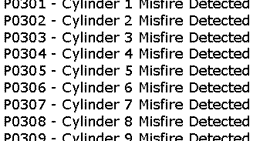 (OBDII trouble codes) |
The trouble codes on all OBDII cars are standardized and each code has the same meaning on all OBDII cars. There could be some minor differences in the way different car manufacturers interpret the same trouble code, but the basic meaning is the same. A typical OBDII trouble code starts with a letter that is followed by four digits. The letter "P" stands for powertrain, the letter "B" for body. For example, if the engine cylinder number 2 would misfire, the car computer (ECM) would turn on the "Check Engine" light and store the diagnostic trouble code P0302 in its memory. If you'd connect the scan tool, it would read something like: P0302 - Cylinder 2 Misfire Detected. Overall, there are a few hundreds trouble codes for the powertrain, but only about 40-50 codes are very common. You can read more what some of the common powertrain codes mean here: OBDII Diagnostic Trouble Codes
Freeze Frame
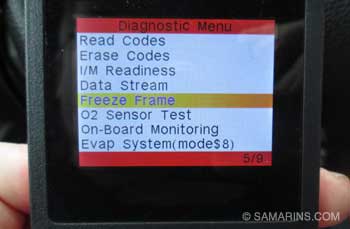 (Freeze Frame sample.) |
A freeze-frame is a snapshot of the engine and transmission parameters at the moment when the engine computer detected a fault and the trouble code was stored. The freeze-frame may show whether the vehicle was stopped or driven at a high speed, whether the air/fuel ratio was lean or rich and whether the engine was cold or fully warmed up at the time of the malfunction. The freeze frame is stored in the engine computer along with the trouble code. How can it be useful? Checking the freeze frame can help identify the problem faster. For instance, if you look at this image, this freeze frame for the code P0116 - Engine Coolant Temperature Circuit Range/Performance indicates that the engine coolant temperature was -40F while the intake air temperature was 84F, which is obviously impossible. The engine temperature should be close to the ambient temperature (intake air temperature) if the car is just started or it should be a lot higher if the engine is warmed up. This means that the engine temperature sensor didn't register the correct temperature. This was most likely caused by either a faulty engine temperature (ECT) sensor or poor connection at the sensor. Looking at this freeze-frame, you also can see that the car was idling at the moment this malfunction was detected (the engine speed showed 756 RPM) and the vehicle was stationary (Vehicle Speed at 0 MPH).
Q: I have a scan tool. How to scan a car for codes?
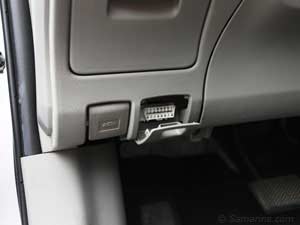
(OBD II Data Link Connector )
A: It's not very difficult to scan your car computer for trouble codes if you have a scan tool or OBDII software and some technical knowledge. Scanning the car computer for codes is easy:
Step 1: Find the DLC Connector. An OBDII-compliant vehicle has a standard diagnostic connector, which is in technical terms called Data Link Connector or DLC. The DLC is identical on all OBDII cars and should be located within three feet of the driver. Usually the DLC connector is located at the lower portion of the dashboard on the driver side, like this one in the photo. In some cars the OBD DLC connector is hidden under a cover, but the connector still looks like the one in the photo.
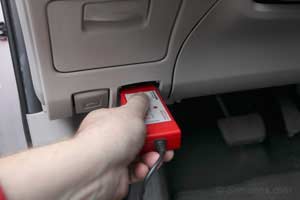
Connecting the scan tool
In some cars the DLC connector might be near the fuse panel; in some Acura cars it's under the ashtray. In some Volkswagen models the DLC connector is hidden under the slide cover at the center console. Some cars have the sign 'OBD' marked on the DLC connector cover.
Step 2: Connect the scan tool: Scanning the engine computer doesn't take much time. You connect the scan tool, turn the ignition ON and follow the scan tool menus to get to the DTCs (Diagnostic Trouble Code) and read the code. If your scan tool can access the freeze frame, check it too, it may help. Check the scan tool manual for details.
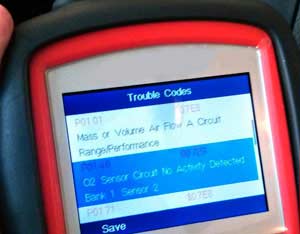
Trouble code displayed on the
OBDII scan tool
OBDII scan tool
Once the fault code is retrieved, more testing is needed to find the defective part, as the code only gives the parameter that is out of range. For example, the DTC P0401 reads "insufficient EGR system flow", but it could be set for a number of reasons, such as a bad EGR valve, clogged EGR passage or a faulty DPFE sensor. Another example: The code P0341- Camshaft Position Sensor Circuit Range/Performance points to the camshaft position sensor, but it could be caused by variety of reasons including stretched timing chain, improper timing, problems with the variable valve timing system etc.
How to diagnose a trouble code:
As I mentioned above, the trouble code itself does not tell exactly which part to replace, so throwing parts at the problem without diagnosing it properly is not the right approach. There is no single way to diagnose a trouble code, as the codes only point to what parameter or signal is out of range. The system or sensor related to the code needs to be tested according to troubleshooting flow-chart found in the service manual. If you don't have the proper equipment nor the access to the service manual, you can try researching for common problems, because usually the same trouble code in the same-model car is often caused by the same type of fault and there is a good chance that it's a known problem and somebody already posted the solution for this problem. For example, if you have Honda CR-V with a code P0134, the research will show you that very often the code P0134 is caused by a faulty front air/fuel ratio sensor.
We did the research for you on many trouble codes and posted possible faults, common examples, areas to check and possible repairs.
If we don't list the code you have in your car, google it along with your car's make, year and model; somebody might have had the same code already and posted the possible repair.
Where can I buy an OBDII scan tool or software?
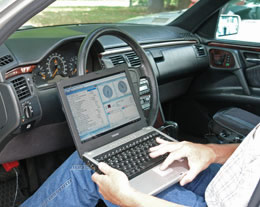 (Using scan tool software) |
An OBDII or EOBD scan tool can be bought at an auto parts store, or online. A simple OBD code reader may cost anywhere from $35 to $200. You also can buy an adaptor with the software for your laptop. There is even an OBDII app for the iPhone, but it requires a separate hardware interface. The software with the adaptor for the laptop cost form $150 to $450, depending on the available functions. If you have some technical knowlege, I'd recommend to buy a scan tool or software that has a capability to display the live data.
An OBDII scan tool should work on any OBDII or EOBD compatible car. An OBDII / EOBD scan tool cannot be used to diagnose the Airbag or ABS light. To diagnose the airbag or ABS issues might need to visit your dealer. Similarly, an OBDII scan tool will not connect to the Body Control Module (BCM).
An OBDII scan tool should work on any OBDII or EOBD compatible car. An OBDII / EOBD scan tool cannot be used to diagnose the Airbag or ABS light. To diagnose the airbag or ABS issues might need to visit your dealer. Similarly, an OBDII scan tool will not connect to the Body Control Module (BCM).
Tips to prevent the Check Engine light from coming on
- Don't overfill the fuel tank. Fill up till the first click of the pump. Overfilling can cause problems with your vehicle's Evaporative emission control systems (EVAP) resulting in the Check Engine light coming on.
- After filling up, make sure the gas cap is tight and the gas cap strap does not get caught under the cap.
- Change engine oil regularly. Long intervals between the oil changes do not directly cause the Check Engine light (MIL) to come on, but many MIL-related problems stem from lack of oil changes.
- After checking or replacing the air filter, make sure it's installed properly. If unfiltered air is allowed into the engine it can cause damage to the vehicle's mass airflow (MAF) sensor, which will turn the MIL on. It's best to use only OEM or known good quality air filters.
- Lack of tune-ups is another common reason for the Check Engine light to come on. Old spark plugs, dirty throttle body, bad ignition wires all can cause engine problems with the Check Engine light coming on.
- The corrosion in the wiring and connectors of the car computer system is another major cause of the Check Engine light problems. Your car or truck is full of electronics with wires and connectors located in many places throughout the vehicle, icluding areas behind the kick panels, under the carpet, in the engine compartment, underneath along the frame, near the gas tank, etc. Anything you can do to keep the electronic modules and wiring free from corrosion will help avoid related problems. For example, if your engine undercover is damaged, it can allow moisture into the engine compartment causing corrosion. Similarly, moisture inside the car can cause corrosion of the wiring under the carpet. Keep the electronics dry.
- When doing repairs, use original parts when possible. Sometimes the Check Engine light comes on because some aftermarket parts like oxygen sensors, mass airflow sensors or catalytic converters can have compatibility issues.
